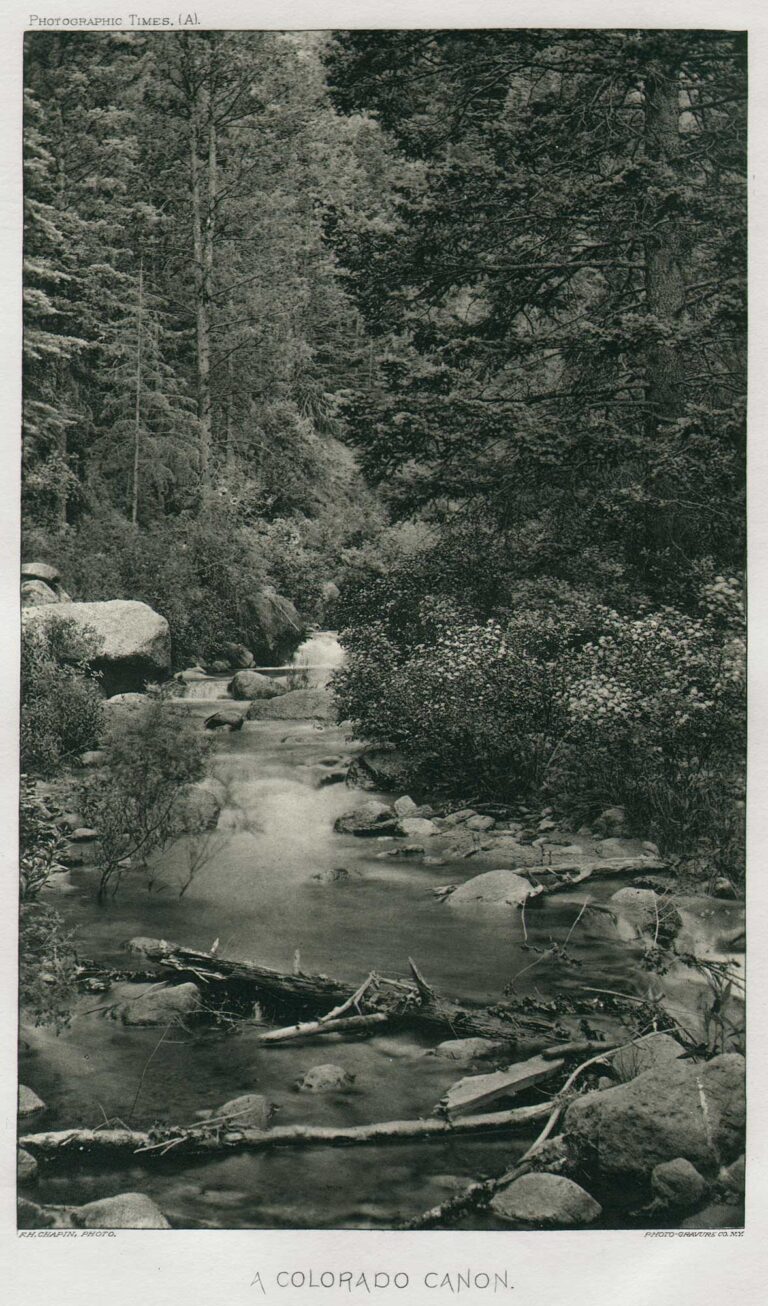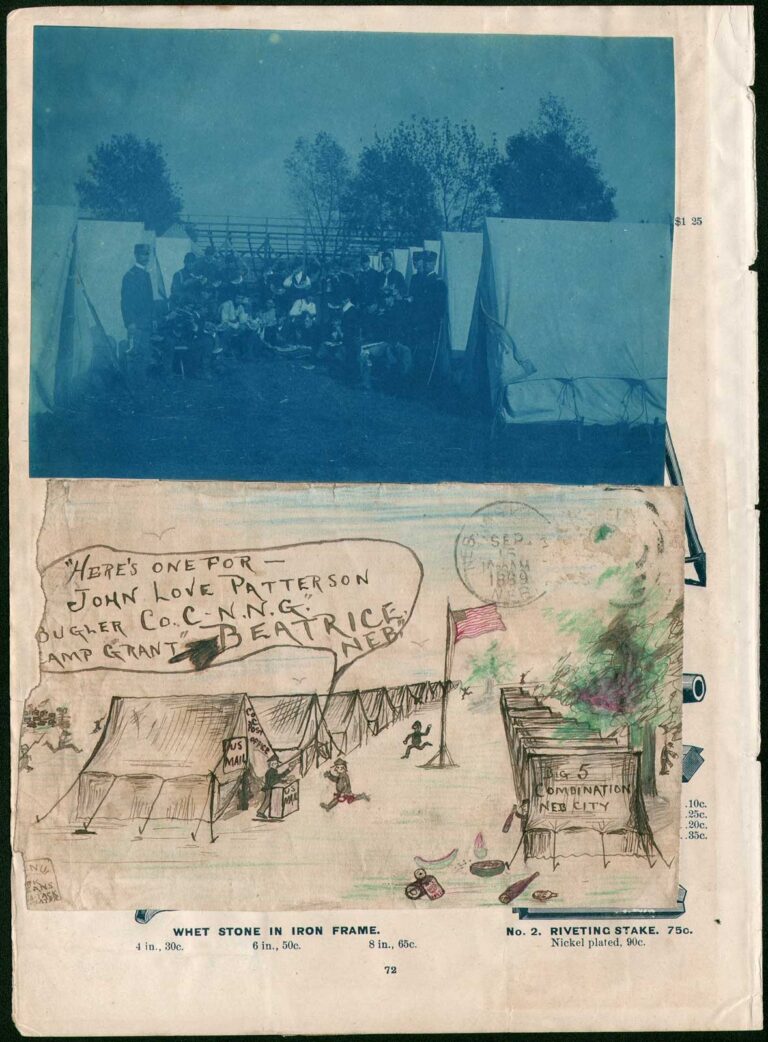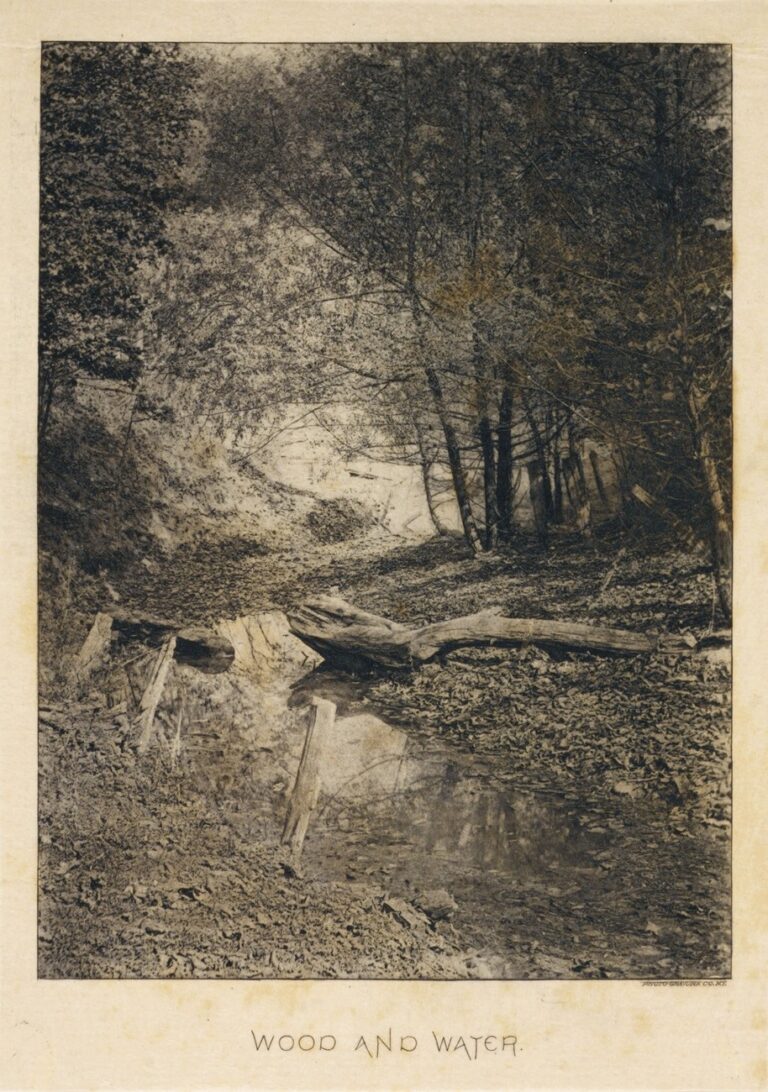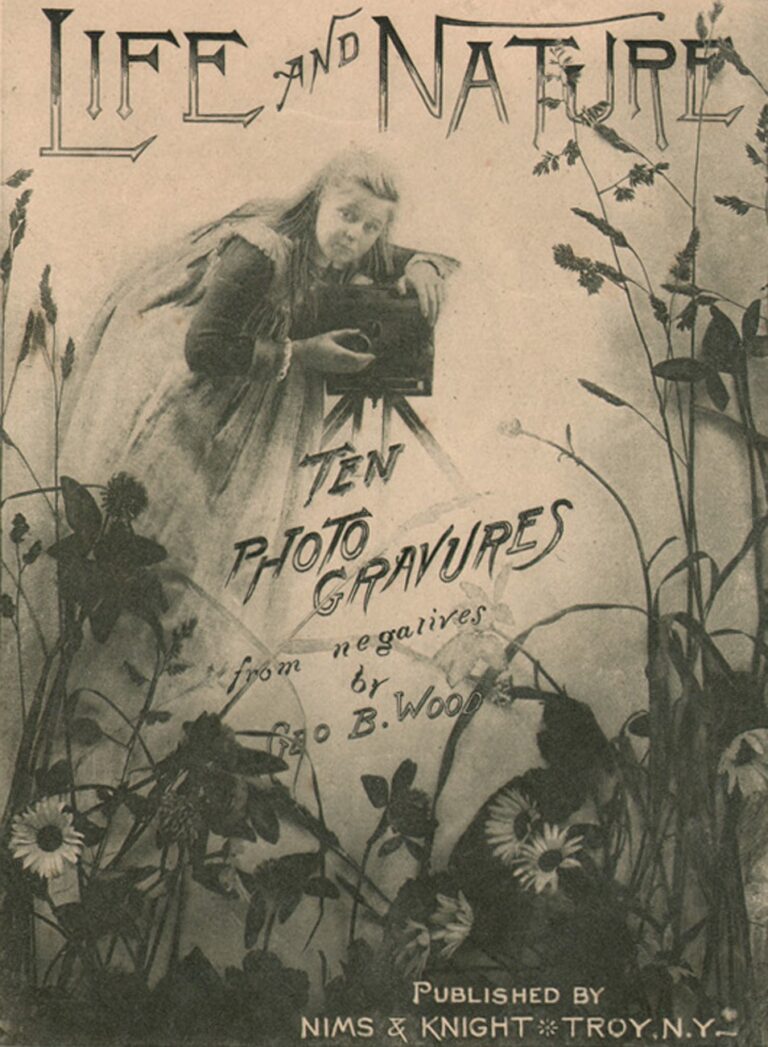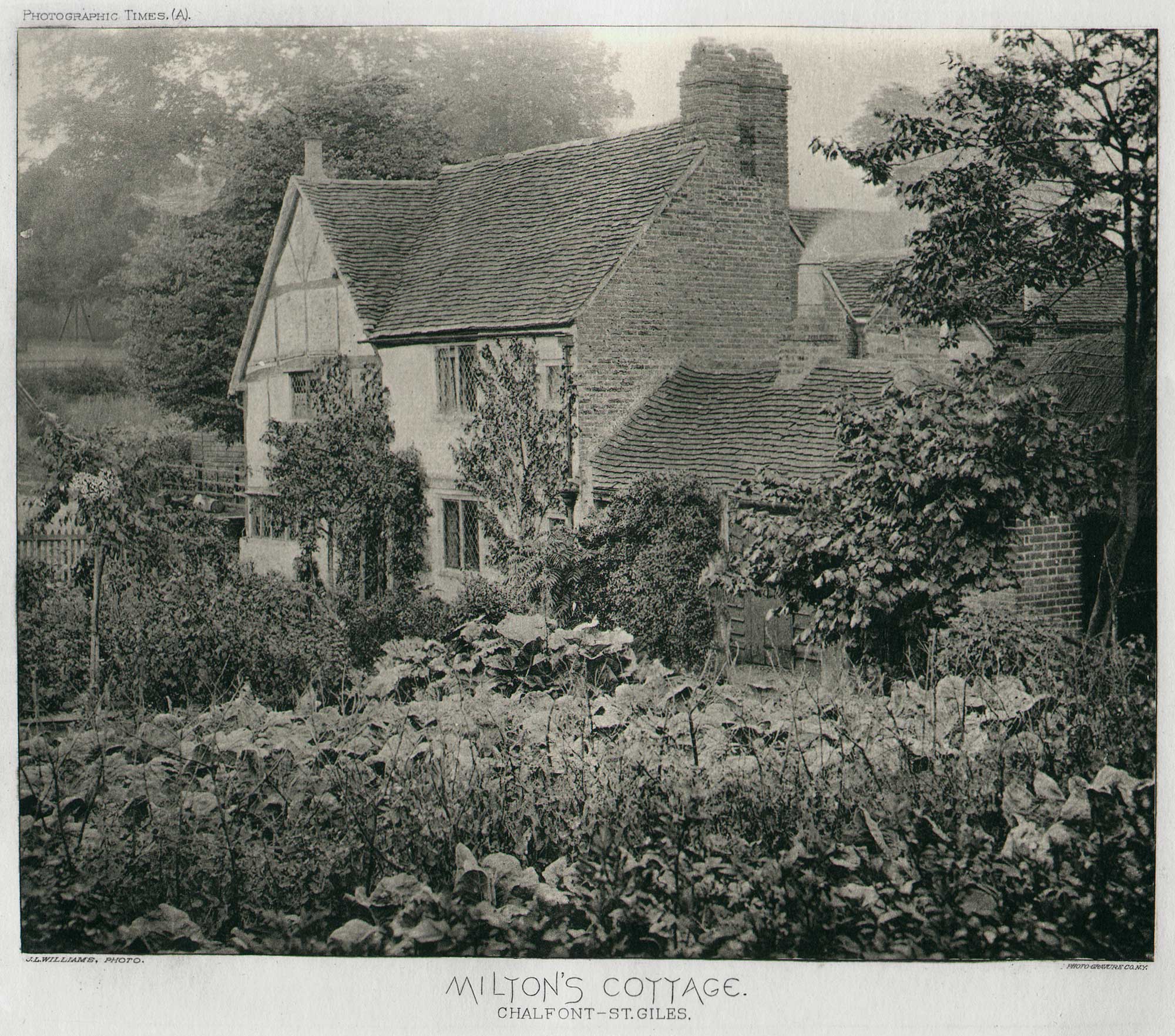
Milton’s Cottage Chalfont – St. Giles
John Milton: 1608-1674
English poet, polemicist, and civil servant. His 1667 epic poem Paradise Lost, written in blank verse and including twelve books, was written in a time of immense religious flux and political upheaval. It addressed the fall of man, including the temptation of Adam and Eve by the fallen angel Satan and God’s expulsion of them from the Garden of Eden. Paradise Lost elevated Milton’s reputation as one of history’s greatest poets. He also served as a civil servant for the Commonwealth of England under its Council of State and later under Oliver Cromwell. ⎯Wikipedia
Editorial Comment for this plate:
MILTON’S COTTAGE.
WE present our readers this week with the first of a notable series of photo-gravures from negatives by Dr. J. L. Williams, an eminent English amateur whose camera has been enlisted in the service of THE PHOTOGRAPHIC TIMES’ readers. The high character of Dr. Williams’ work, both as to its artistic and technical qualities, is fairly shown in the first picture of the series, which makes its appearance this week. Other pictures will be figure compositions with pictorial landscapes, as well as pure landscapes and figure pictures. A descriptive article like the one which follows will be an interesting feature of this series of pictures by Dr. Williams. But more is said of this matter in another column.
Our readers want to know what Dr. Williams has to say in regard to this individual picture. He writes: “It may interest many of my photographic friends to know that the picture accompanying this was taken, as many others which I have made in England were, during a rain storm. After a waste of no small amount of energy and useless effort over the weather, I determined to have some sort of pictures, rain or shine. As it rains considerably more than it shines in that lachrymose country, I managed to obtain a large collection of what may be called ‘wet’ pictures on ‘dry’ plates. In the article which follows, Dr. Williams tells us some interesting things about Milton’s Cottage.
MILTON’S COTTAGE AT CHALFONT-SAINT-GILES.
I STOOD at the Baker Street Station of the London Underground Railway one June morning last summer, camera in hand, deliberating which way to go for a day’s outing, when my eye caught a large, showily printed placard which read somewhat as follows: “Extension of the Saint John’s Wood Branch of the Metropolitan Railway to Harrow-on-the-Hill, Pinner, Rickmansworth and Chalfont-Saint-Giles.” I had already heard of the picturesque attractions of these places, and some brief mention in the advertisement of a cottage in which Milton had once lived decided me to explore the territory. My first stop was at Harrow-on-the-Hill, most picturesquely situated and rich in historical associations connected with its famous school. I climbed up the long Hill street and wandered about the old churchyard until I discovered Byron’s favorite seat on an old tombstone, which I at once recognized from the pictures which I had often seen of it. The view from this point out over the wide, pastoral valley is very beautiful. Another ride of a few miles and I leave the train at Rickmansworth, a typical old English village, with its ivy-covered church tower, timber front houses with projecting gables, and what adds much to its general picturesqueness a stream of clear water winding about among the cottages and along the streets. A most enjoyable lunch of peat-smoked bacon and fried eggs, with the fitting accompaniment of a mug of home brewed ale, at the old village inn, and then we once more take train for Chalfont.
Arrived there we find our destination is still three and a half miles away and it is not possible to obtain a conveyance. Well, there are some advantages in walking, and we set out on what proves to be a most delightful tramp through country lanes and woods, until at last we come out on the summit of a hill overlooking one of the most beautiful valleys in England. Away at the southern extremity of this valley is the village containing the chief object of our day’s exploration. The Milton cottage is the last one on the left of the one long street which constitutes the village. It is pointed out to us by some school boys who seemed only too glad to place us in their debt that they may silently claim the right to watch the mysterious operation of making a photograph. The room in which “Paradise Lost” was finished is shown for a small consideration. The woman who shows it professes that it is in precisely the same condition as when it was the study of the great poet. It contains a few pieces of rudely carved oak furniture, together with a show case in which are some of the earlier editions of Milton’s works, and a larger illustrated work on natural history on the title page of which is the poet’s name in his own handwriting.
In 1665, while the great plague was raging in London, Milton wrote to a former pupil, a young Quaker by the name of Ellwood, who then resided at Chalfont-Saint-Giles, asking him to find a refuge for him in his neighborhood. Ellwood left a very carefully written account of his own life from which we take the following interesting description of Milton’s residence at this place:
“I took a pretty box for him,” he says, “in Giles Chalfont, a mile from me, of which I gave him notice and intended to have waited on him and seen him well settled in it.” But young Ellwood was arrested with many other Quakers, who were being persecuted at this time, and was thrown into prison. He was, however, soon set at liberty, and on returning to Chalfont hastened to call on his old master.”After some common discourses had passed between us, he called for a manuscript of his, which being brought he delivered to me, bidding me take it home with me and read it at my leisure; and when I had so done return it to him with my judgment thereupon. When I came home and set myself to read it, I found it was that excellent poem which he entitled ‘Paradise Lost.’ After I had with the best attention read it through I made him another visit and returned him his book. He asked me how I liked it and what I thought of it, which I modestly and freely told him; and after some further discourse about it I pleasantly said to him: Thou hast said much here of Paradise Lost; but what hast thou to say of Paradise Found.’ He made me no answer, but sat some time in a muse.
After the sickness (the plague) was over and the city well cleaned and become safely habitable again, he returned thither; and when afterwards I went to wait on him there (which I seldom failed of doing whenever my occasions led me to London) he showed me a second poem, called ‘Paradise Regained,’ and in a pleasant tone said to me: This is owing to you for you put it into my head by the question you put to me at Chalfont, which before I had not thought of.’’
What would the world not give for a similar bit of reminiscence, as ingenuous as the above, concerning Milton’s great predecessor who, at this time, had only been dead fifty years?
Another three and a half mile walk back to the station and we return to London weary, but enriched with delightful and never-to-be-forgotten experiences.
J. L. Williams. (pp. 563-64)
